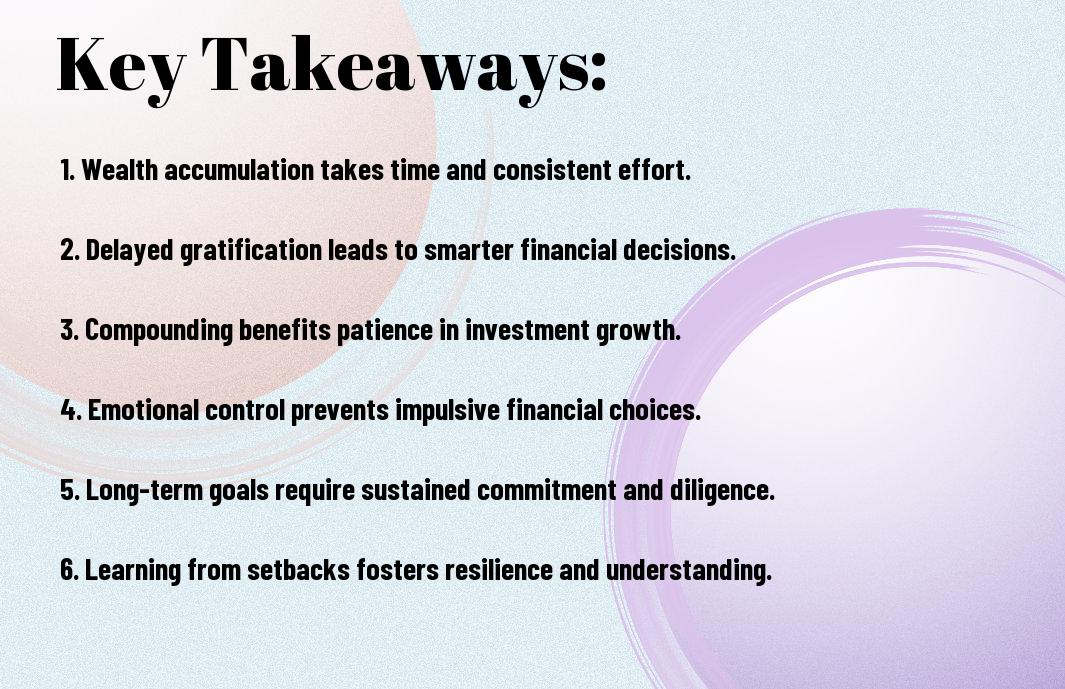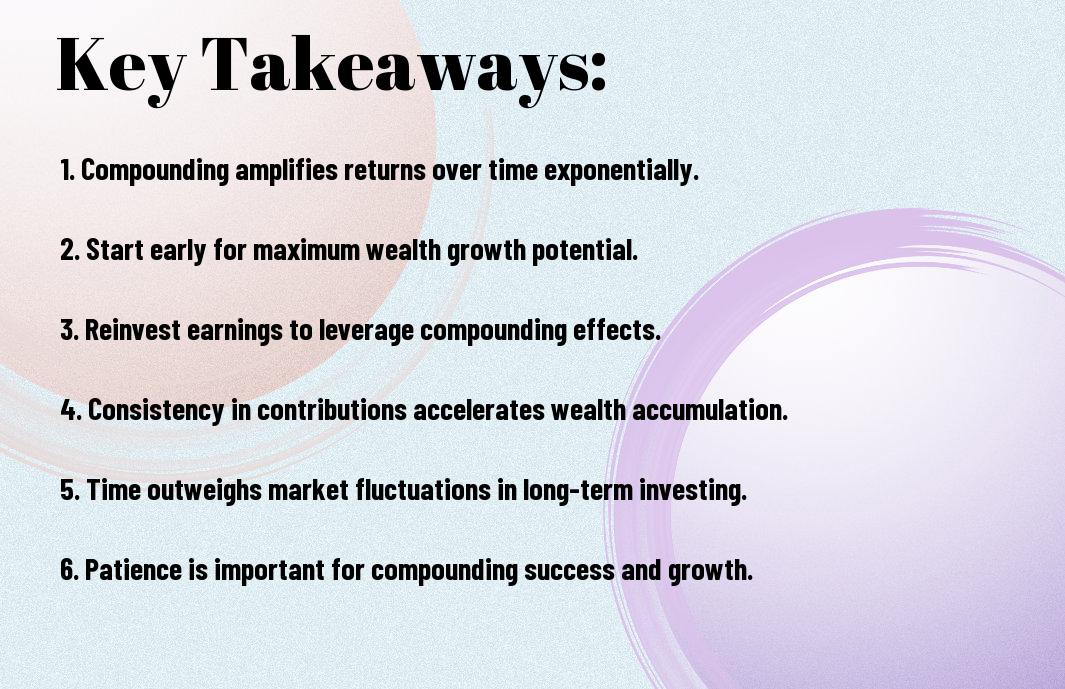Most individuals aspire to achieve financial security and long-term wealth, but building an effective financial plan can often feel overwhelming. The good news is that with clear steps and a well-defined strategy, you can create a robust plan that aligns with your financial goals. In this post, we will guide you through the vital components of financial planning, so you can establish a foundation for lasting wealth. For more detailed insights, check out our resource on How to Create a Financial Plan for Long-Term Wealth.
Key Takeaways:
- Set Clear Goals: Define your long-term financial objectives, such as retirement, buying a home, or funding education.
- Create a Budget: Establish a monthly budget that aligns with your goals and tracks income and expenses effectively.
- Build an Emergency Fund: Save at least 3-6 months’ worth of expenses to protect against unexpected financial challenges.
- Invest Wisely: Diversify your investment portfolio to balance risk and reward while focusing on long-term growth.
- Review Regularly: Assess your financial plan periodically to ensure it remains relevant and adjust it based on life changes or market conditions.

Understanding Your Current Financial Situation
Your financial journey begins with a clear understanding of your current situation. This involves analyzing your assets, liabilities, income, and expenses to form a solid foundation in your financial plan. For more insights, check out What Is a Financial Plan, and How Do You Build One?
Assessing Assets and Liabilities
Assets are everything you own that has value, such as cash, investments, real estate, and personal property. Liabilities, on the other hand, encompass all your debts, including mortgages, loans, and credit card balances. To gain insight into your net worth, subtract your total liabilities from your total assets.
Evaluating Income and Expenses
Assessing your income and expenses is necessary for creating a comprehensive financial plan. You need to identify all sources of income, including salaries, bonuses, and passive income, and track your monthly expenditures, such as bills, groceries, and discretionary spending. This process helps you understand your cash flow and identify potential areas for improvement.
Further breaking down your monthly expenses allows you to spot spending patterns and pinpoint where you can cut back. By developing a clear budget reflecting your priorities, you can align your spending with your financial goals, paving the way for long-term wealth accumulation.
Setting Clear Financial Goals
The foundation of a successful financial plan lies in setting clear financial goals. By defining what you want to achieve, you’ll create a roadmap that guides your decisions and actions. Your financial goals should reflect your values and aspirations, helping you stay motivated as you progress towards long-term wealth. Whether you aim to purchase a home, save for retirement, or invest in education, outlining specific objectives will empower you to take charge of your financial future.
Short-Term vs. Long-Term Goals
Goals can generally be categorized into short-term and long-term. Short-term goals are typically achievable within a year and may include saving for a vacation or paying off credit card debt, while long-term goals span several years, like funding your child’s education or securing a comfortable retirement. Distinguishing between these types will help you prioritize your efforts and allocate resources effectively.
SMART Goals Framework
Across all your financial aspirations, implementing the SMART goals framework can enhance clarity and focus. This approach encourages you to set goals that are Specific, Measurable, Achievable, Relevant, and Time-bound. By ensuring your financial goals meet these criteria, you can maintain motivation and track your progress more effectively.
At its core, the SMART goals framework transforms vague objectives into actionable steps. For example, instead of setting a goal to “save money,” you could establish a specific target like “save $5,000 for a vacation within the next year.” This specification makes it easier to quantify your progress and adjust your strategies as needed. By following this structured approach, you position yourself for greater success in achieving both short-term and long-term financial aspirations.
Creating a Comprehensive Budget
Despite the variety of financial goals you may have, a comprehensive budget serves as the foundation of your long-term wealth strategy. It allows you to track your income, manage expenses, and allocate funds towards savings and investments. By tailoring a budget that aligns with your personal goals, you’re taking an necessary step toward achieving financial stability and growth over time.
Budgeting Techniques
Behind every successful budget lies effective budgeting techniques that can help you gain control over your finances. Whether you prefer the envelope system, zero-based budgeting, or the 50/30/20 method, experimenting with different approaches can lead you to the strategy that best meets your needs. You should assess your spending habits and choose a method that reflects your lifestyle and financial objectives.
Tracking and Adjusting Your Budget
Between setting up your budget and achieving financial success, consistent tracking and adjusting are necessary to stay on course. By monitoring your expenses and income, you can identify trends, avoid overspending, and make informed adjustments as needed. This accountability promotes better financial habits and helps you stay aligned with your long-term wealth goals.
To maintain an effective budget, implement a regular review schedule, such as monthly or quarterly check-ins. This allows you to assess your financial situation, recognize patterns, and refine your budget accordingly. As life circumstances change, including job shifts and unexpected expenses, being adaptable in your budgeting initiatives will enable you to remain focused on your long-term wealth objectives.
Investment Strategies for Wealth Building
Now is the time to explore effective investment strategies that can help you build long-term wealth. Diversifying your portfolio across various asset classes allows you to mitigate risk and capitalize on different market conditions. Developing a thoughtful investment plan tailored to your financial goals and situation is imperative for maximizing your returns.
Types of Investments
Now let’s discuss the various types of investments available to you:
| Stocks | Equity ownership in a company, offering potential for high returns. |
| Bonds | Loans to governments or corporations, usually providing steady income. |
| Real Estate | Physical property investments that can yield rental income and appreciation. |
| Mutual Funds | Investment vehicles pooling money from many into diversified portfolios. |
| ETFs | Exchange-traded funds offering broad market exposure with lower fees. |
Any investment you consider should align with your financial goals and how much risk you can comfortably take on.
Risk Tolerance and Time Horizon
One key aspect of your investment strategy involves understanding your risk tolerance and time horizon. Assessing how much risk you are willing to take is vital for making informed decisions that fit your comfort level and financial objectives.
For instance, if you have a long time horizon, such as 20 years until retirement, you may choose to allocate more of your portfolio to higher-risk investments like stocks, which can offer greater potential returns. Conversely, if your timeframe is shorter, you may prefer more conservative options like bonds or cash equivalents that prioritize capital preservation. Balancing these factors can guide you in creating a well-rounded investment portfolio.
Importance of Emergency Funds
To achieve long-term wealth, it’s imperative to have an emergency fund that provides financial security in unexpected situations such as job loss or medical emergencies. This fund acts as a safety net, helping you avoid relying on credit cards or loans. Start by setting aside three to six months’ worth of living expenses. For resources on How to Create a Financial Plan, consult financial experts or use budgeting tools.
Savings Strategy
To build an effective savings strategy, set clear financial goals and automate your savings by setting up regular transfers to your emergency fund. Consider high-interest savings accounts or money market accounts for better yield. Prioritize this savings strategy in your overall financial planning to ensure funds are readily available for unforeseen circumstances.
Accessing Funds When Needed
Against a background of financial uncertainty, knowing how to access your emergency funds quickly can alleviate stress. Your emergency fund should be easily reachable, preferably kept in a savings account that allows prompt withdrawals. Avoid tying these funds up in long-term investments, as they may be challenging to liquidate when urgent needs arise.
With a well-structured plan, you can ensure your emergency funds are both accessible and functional. Consider online banking, which often provides quicker access to your funds compared to traditional banks. This approach guarantees that when unexpected circumstances occur, you have swift access to the resources you need, allowing you to handle challenges without delay.

Regularly Reviewing and Adjusting Your Plan
Many people overlook the importance of regularly reviewing and adjusting their financial plans. Your financial goals, income, and expenses can change over time due to various factors such as career shifts or market conditions. By routinely examining your financial plan, you ensure that it remains aligned with your long-term objectives, allowing you to make informed decisions that enhance your path to wealth accumulation.
Monitoring Progress
Below are some important metrics to track your progress: net worth growth, adherence to your budget, and performance of your investment portfolio. Regularly assessing these factors will give you a clearer picture of how close you are to reaching your financial goals. This consistent monitoring also helps you identify any gaps that need addressing, ensuring you stay on the right track toward wealth building.
Adapting to Life Changes
Progress is not static, and your financial plan should reflect your evolving life circumstances. Whether you experience a change in income, take on new responsibilities, or reach important milestones, adapting your plan is vital. These adjustments ensure that your financial strategies keep pace with your current reality, enabling you to maintain focus on your long-term wealth goals.
And as life unfolds, you may encounter events such as marriage, children, or career changes that necessitate a reevaluation of your financial strategies. Each of these life changes can alter your financial landscape, making it important to adjust your savings, investments, and expenditures accordingly. By being proactive in adapting your financial plan, you position yourself to navigate life’s uncertainties while continuing your journey toward long-term wealth.
Summing up
Upon reflecting on how to build a financial plan for long-term wealth, you should prioritize setting clear financial goals, budgeting effectively, and investing wisely. By understanding your risk tolerance and regularly reviewing your plan, you can adjust to changes in your life and the market. Additionally, consider diversifying your investments and seeking professional advice when necessary. With diligence and patience, you can create a strategy that supports your financial future and ultimately leads to lasting wealth.
FAQ
Q: What are the first steps to creating a financial plan for long-term wealth?
A: The first steps in creating a financial plan for long-term wealth include assessing your current financial situation, setting clear and achievable financial goals, and establishing a budget. Begin by analyzing your income, expenses, assets, and liabilities. Next, define what long-term wealth means for you—this could involve saving for retirement, purchasing a home, or investing in education. Once you have a clear understanding of your finances and goals, develop a budget that allocates resources efficiently towards saving and investing.
Q: How important is investment diversification in a financial plan?
A: Investment diversification is key to managing risk in a financial plan aimed at long-term wealth accumulation. By spreading investments across various asset classes—such as stocks, bonds, real estate, and commodities—you can cushion your portfolio against significant losses. Different assets may react differently to market conditions, and having a diverse portfolio can smooth out the volatility over time. Ensure that your investment choices align with your risk tolerance and time horizon; this approach can foster steadier growth toward your financial goals.
Q: What role does emergency savings play in a long-term financial plan?
A: Emergency savings are an imperative component of a long-term financial plan as they provide financial security and stability. Setting aside three to six months’ worth of living expenses helps protect you against unexpected financial emergencies, such as job loss or medical expenses. With this safety net in place, you can focus on long-term investments and wealth-building strategies without the stress of immediate financial disruptions. By prioritizing emergency savings, you enhance your overall financial resilience and maintain the ability to achieve your wealth goals.







